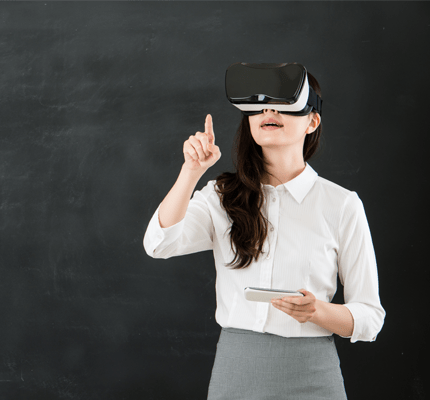
Is Virtual Reality the Future of the Public Speaking Course?
When virtual reality (VR) is discussed in the media, articles often focus on watching TV or playing video games. However, virtual reality also has the potential to enhance teaching. In a new article published in NCA’s Communication Education, Alyssa Davis, Darren L. Linvill, Larry F. Hodges, Albert Florencio Da Costa & Alexzander Lee examine how students can use VR technology to practice speeches for a public speaking course and potentially reduce their Communication Apprehension (CA).
Many students experience CA. Students may experience fear of public speaking generally or situationally. Davis, Linvill, Hodges, Da Costa, and Lee explain that practicing public speaking skills during and after class helps relieve situational anxiety for some students. However, students with more severe apprehension may avoid working on and practicing their speech, which can lead to a lower quality speech and unhappiness with their work in the public speaking course.
VR may help by giving students an opportunity to practice their skills and reduce their CA. During an Introduction to Human Communication Course, the authors recruited 195 students for their study. For the study, students either attended a practice session for their informative speech with peer groups or practiced their speech using VR technology at the Communication Center on campus. The informative speech is the students’ first formal speech. It requires an outline and sources, is 5 -7 minutes long, and is graded based on NCA’s 8 public speaking competencies.
Students were scheduled for time slots in groups of three and then randomly assigned to either the face-to-face peer group or VR. One hundred twenty-seven students practiced with peer groups, and 69 students practiced using VR technology. Students in both groups then completed surveys about their practice experiences. In peer groups, students practiced in pairs; students using VR technology practiced their presentation alone using the technology.
When students entered the VR environment, they were asked to identify three objects in the virtual environment to demonstrate their familiarity with the software. Then, students were welcomed into a virtual classroom. The virtual classroom included images of real students that had been captured during a summer course. The authors took care to replicate student behavior that students might see during their speeches: “One student was smiling and nodding, another looked like he was about to fall asleep, a third shuffled through his backpack at some point in the recording.” In addition, students were provided time cues and were permitted to look at notecards that they had brought with them.
Results showed that students who used the VR technology received final speech grades that were similar to those received by students who participated in the peer groups. However, students who used the VR technology felt more apprehension while practicing than students participating in the face-to-face practice session.
The authors also presented the data to the students and asked students for additional feedback. All participants felt that both sessions helped them to feel prepared and less anxious for their speech. Students who had used the VR technology suggested that the audience members who engaged in distracting behavior, such as sleeping or looking in their backpack, contributed to their apprehension.
Implications
Davis, Linvill, Hodges, Da Costa, and Lee conclude that although VR causes more apprehension, it can also help students overcome CA because students could desensitize themselves to public speaking by practicing in front of an audience, potentially more efficiently than in person. They suggest that VR technology could be used in future public speaking courses because it would enable students to practice on their own time, without scheduling time with classmates. However, the authors also expressed concerns that the novelty of the technology might make it somewhat distracting.
Furthermore, due to the cost, VR may not be accessible to all students. Thus, the authors suggest that it might be helpful for students to practice at a location such as the Communication Center, where they could receive additional services. The authors note that VR is not a replacement for tutoring services generally, and that it should be used in conjunction with in-person tutoring. Finally, Davis, Linvill, Hodges, Da Costa, and Lee note that VR technology may be useful in online or hybrid class formats.






